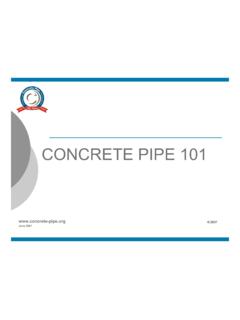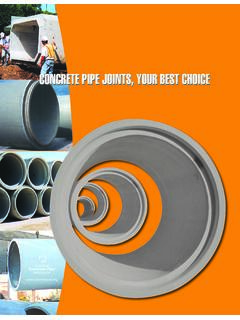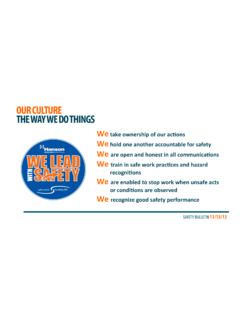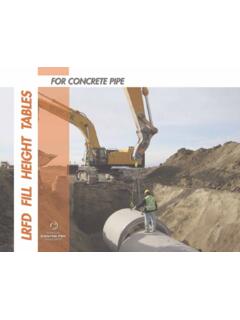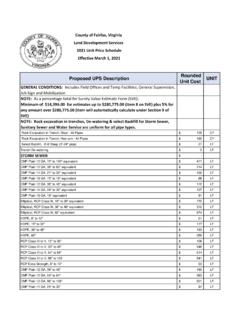Transcription of Highway Live Loads on Concrete Pipe
1 Highway live Loads on Concrete PipeForewordThick, high-strength pavements designed for heavy truck traffic substantially reduce the pressure transmitted through a wheel to the subgrade and, consequently, to the underlying Concrete pipe . The pressure reduction is so great that generally the live load can be neglected. In 1926, Westergaard presented a paper summarizing the results of an extensive study of the effects of loading conditions, subgrade support, and boundary conditions on Concrete pavements(1). These results formed the basis by which Westergaard developed a method to calculate the stresses in Concrete slabs. Based upon the work of Westergaard and others, the Portland Cement Association, (PCA), developed a method to determine the vertical pressure on buried pipe due to wheel Loads applied to Concrete pavements(2).
2 The PCA method is presented in the American Concrete pipe Association, ACPA, Concrete pipe Handbook (3) and Concrete pipe Design Manual (4).Intermediate and thin thicknesses of asphalt or flexible pavements do not reduce the pressure transmitted from a wheel to the pavement subgrade to any significant degree. For these pavements, there is no generally accepted theory for estimating load distribution effects, and, therefore, these pavements should be considered as unsurfaced of Highway Loads in the US often follows the American Association of State Highway and Transportation Officials, AASHTO, critieria. The AASHTO LRFD Bridge Design Specifications specifies the applicable Highway Loads and their distribution through the soil.
3 This Design Data addresses the method of determining the live load pressure transmitted through unsurfaced roadways to circular, elliptical and arch Concrete pipe in accordance with the criteria of the AASHTO LRFD Bridge Design Specifications . IntroduCtIonTo determine the required supporting strength of Concrete pipe installed under intermediate and thin thicknesses of asphalt or flexible pavements, or relatively shallow earth cover, it is necessary to evaluate the effect of live Loads , such as Highway truck Loads , in addition to dead Loads imposed by the soil and surcharge LoadsIf a rigid pavement or a thick flexible pavement designed for heavy duty traffic is provided with a sufficient buffer between the pipe and pavement, then the live load transmitted through the pavement to the buried Concrete pipe is usually negligible at any depth.
4 If any culvert or sewer pipe is within the heavy duty traffic Highway right-of-way, but not under the pavement structure, then such pipe should be analyzed for the effect of live load transmission from an unsurfaced roadway, because of the possibility of trucks leaving the pavement. dead LoadsVarious methods for analyzing soil dead Loads , which have been developed over the years, are presented in the ACPA Concrete pipe Technology Handbook (7). surCHarge Loads A common type of surcharge load is additional soil fill placed after the pipe has been installed for a period of time. If the surcharge load is a building or other surface load , the resultant uniformly distributed load can be converted to an equivalent height of fill, and then evaluated as an additional soil load .
5 When Concrete pipe has been installed underground, the soil-structure system will continually show an increase in load capacity. Data on Concrete pipe , which have been removed from service and tested, indicate an increase in Concrete strength and an increase in load carrying capacity of 10 to 40 percent. Settlement and consolidation will improve the soil structure surrounding the pipe , which also improves load carrying capacity. live LoadsThe AASHTO design Loads commonly used in the past were the HS 20 with a 32,000 pound axle load in the Normal Truck Configuration, and a 24,000 pound axle load in the Alternate load Configuration (Figure 2).
6 The average pressure intensity caused by a wheel load is calculated by Equation 3. The AASHTO LRFD design Loads are the HS 20 with a 32,000 pound axle load in the Normal Truck Configuration, and a 25,000 pound axle load in the Alternate load Configuration (Figure 2). Design Data 11 American Concrete pipe Association 1 (07/09) 2009 american Concrete pipe association, all rights FaCtorsThe AASHTO LRFD Standard applies a dynamic load allowance to account for the truck load being non-static. The dynamic load allowance, IM, is determined by Equation 1:IM = [1]10033( - )where: H = height of earth cover over the top of the pipe , dIstrIButIonThe surface load is assumed to be uniformly spread on any horizontal subsoil plane.
7 The spread load area is developed by increasing the length and width of the wheel contact area for a load configuration as illustrated in Figure 3 for a dual wheel; in Figure 4 for dual wheels of two trucks in passing mode; and in Figure 5 for two dual wheels of two Alternate load configurations in passing mode. On a horizontal soil plane, the dimensional increases to the wheel contact area are based on height Figure 1 aasHto wheel load surface Contact area (Foot Print)table 1 LrFd wheel surface Contact areaFigure 2 aasHto wheel Loads and wheel spacingstable 2 LrFd wheel Contact area dimensional Increase Factor16000 lb.
8 HS 20 load 12500 lb. LRFD Alternate load ft. (20 in.) ft. (10 in.)baHS 20 LoadLRFD Alternate Load4000 ft. to 30 20 Load4000 20 & LRFD Alternate Loads12500 HS 20, 32,000 pound and the Alternate Truck 25,000 pound design axle are carried on dual wheels (Figure 1). The contact area of the dual wheels with the ground is assumed to be a rectangle (Figure 1), with dimensions presented in Table (width), ft(in.)b(length, ft(in.) (20) (10)soil type dimensional Increase FactorLRFD select any other Concrete pipe Association 1 (07/09) 2009 american Concrete pipe association, all rights earth cover over the top of the pipe as presented in Table 2 for two types of indicated by Figures 3, 4 and 5, the spread load areas from adjacent wheels will overlap as the height of earth cover over the top of the pipe increases.)
9 live load will also dissipate through the Concrete pipe itself resulting in an effective length that resists this load as demonstrated in Figure 7. The effective supporting length of pipe is:Le = L + (3/4Ro) [2]where: RO = outside vertical rise of pipe , feetThe governing wheel load configuration is thus table 3 LrFd Critical wheel Loads and spread dimensions at the top of the Pipea combination of the overlap in live load pressures distributed through the soil, as well as any instance where the effective lengths from adjacent tires overlap within the pipe itself as shown in Figure 8.
10 These conditionshave been summarized in Table shallow depths, the maximum pressure will be developed by an HS 20 dual wheel, since at 16,000 pounds it applies a greater load than the 12,500 pound Alternate load (Figures 2 and 3). At intermediate depths, the maximum pressure will be developed by the wheels of two HS 20 trucks in the passing mode, since at 16,000 pounds each, the two wheels apply a greater load than the 12,500 pounds of an Alternate load wheel (Figures 2 and 4). At greater depths, the maximum pressure will be developed by wheels of two Alternate load configuration trucks in the passing mode, since at 12,500 pounds each, the four wheels apply the greatest load (50,000 pounds) (Figures 2 and 5).


